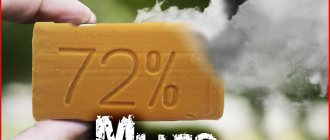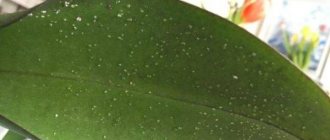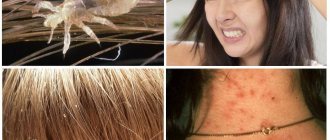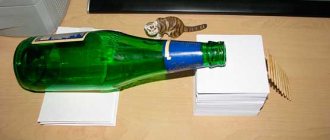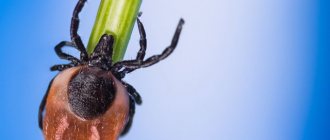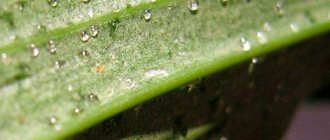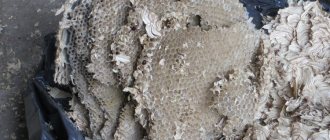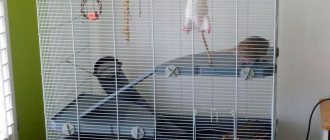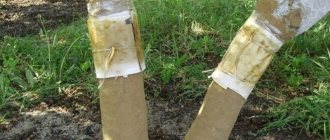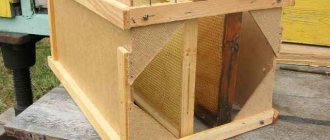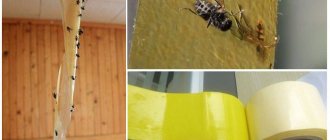In the summer, the appearance of flying insects in the house is especially annoying. At the same time, it prevents people from opening windows and resting normally. Especially flies, which not only buzz and crawl over the body, but also land on food.
Flies lay about 100 eggs at a time, and they can end up on anything. To get rid of the problem, adhesive tapes were invented. But frequent replacement of tapes makes you think about making them yourself.
The life cycle of a fly and the danger it poses
Flies are quite annoying insects, which (without knowing special means) are almost impossible to get rid of.
But in order to understand how best to deal with them, you need to know why they are dangerous and what their lifestyle is. So, the fly has a rather short life cycle, which can be divided into several stages.
- Laying eggs. At one time, the fly can lay up to 150 eggs. She usually chooses damp places for this - manure, garbage pits, etc. That is, all places that are unfavorable for humans are favorable for her.
- Maturation of the larva. It hatches from an egg in a fairly short time - this requires from 8 to 24 hours. The process of larval development also occurs quite quickly - from 5 to 15 days. It feeds on the food in which the eggs were laid.
- Pupation. To do this, the larva moves to a dry place and there turns into a pupa. This process takes three to four weeks.
The fly is a carrier of infection and dirt. The appearance of an adult fly.
She is able to live up to 30 days and during this fairly short period of time lay a large number of eggs (up to 2000 pieces). Since flies are born and live in rather unfavorable conditions, they are capable of carrying a large number of diseases - both parasitic and bacterial. Among the first are parasitic worms, roundworms, and salmonellosis. Among the second: cholera, typhoid, jaundice, listeriosis, etc. In addition, taking into account the habitat of flies, it is worth understanding that when it lands on food in your home, it can carry various types of dirt.
An unusual option for fighting is predator plants
Plants that feed on small flies, mosquitoes and other insects. They do not require special care, tolerate unfavorable conditions well and do not take up much living space, but, nevertheless, they fight flies well.
In conclusion, it is worth noting that the reproduction of flies occurs quite quickly, which is why they are extremely popular among biologists. They are an ideal object for conducting many experiments. The genetic code of these insects has many similarities with humans. Thanks to this, scientists have the opportunity to develop new means of combating cancer and hereditary diseases.
To a greater extent, fruit flies are not pests; they process waste and enhance decomposition processes, returning minerals and oxygen to the cycle of substances, but, nevertheless, they extremely poison human life. When used in combination, the remedies proposed in this article will help make life easier and get rid of annoying fruit flies.
Tags: fruit fly, trap, hand, yours, vinegar
About the author: admin4ik
« Previous entry
Homemade fly strips
If you don’t want to spend money on such a trifle, then you can make Velcro yourself.
From rosin
There are many recipes. Let's look at a few of the most popular ones.
Application of rosin:
- 30 g of rosin with 20 g of castor oil are placed in a tin can. The container is heated by immersing it in hot water. Iron conducts heat well, and the composition in the jar will heat up quickly. A few tablespoons of honey or jam are poured into the resulting mass and spread onto paper with a brush.
- Pine resin 300 g, 10 g wax, linseed oil 150 g, 50 g molasses or honey.
- 300 g rosin, 60 g jam or jam, 200 g linseed oil.
- 400 g rosin, 100 g pure bee honey, 200 ml castor oil, 40 ml glycerin oil.
First, purchase paper strips for depilation or use plain thick paper. Cosmetic strips are much better because of the synthetic fiber in the composition, which retains the sweet mass and does not absorb it.
Rosin is always heated in a water bath, just like resin. All ingredients are placed in tin cans, which can then be thrown away. When the resin begins to melt, stir it so that there are no undissolved pieces. Other ingredients are added to the melted rosin. The mass should turn into a homogeneous mixture, with a single color.
Prepare the paper, make a hole for the rope and a plastic jar at the other end. Wide sheets are cut in half.
The spreadable composition should be hot and viscous. When cooled down, immediately reheat and continue working. The layer is smeared with a thickness of 1-2 mm so that the mass does not flow down the edges and the fly does not escape from captivity.
From a tin can
The used tin can is wrapped with electrical tape or tape. Then the tape is peeled off, leaving a sticky mark on the can from the adhesive side of the tape. A light source is left inside the jar to attract more flies at night.
From a plastic bottle
Bottles are used to make useful items: from drinking bowls to slippers. Use scissors to cut out the top and unscrew the lid. Pour water inside the bottle. Add a little sugar and mix thoroughly. Fresh yeast and a spoonful of honey are also added to the water. The upper cut part is turned over and inserted into the remaining lower section.
There should be a distance between the bottle with syrup and the neck so that the fly can fly inside. Once an insect is trapped, it will not be able to get out.
Scotch
This is the easiest way. There is no need to come up with additional ingredients, cook, or spread. Pieces of tape are hung around the house. Their length should be such that all household members can easily move without touching the adhesive tape.
From tree resin
You can buy it at a gardening store or collect it yourself. Vegetable or castor oil is added to the resin, and sugar is used instead of jam or honey. To enhance the stickiness of the composition, add wax or turpentine. If you take wax, then you need no more than 10 g of the substance per 200 g of resin.
Cut strips up to 8 cm wide and no more than 1.5 m long. Wax and resin are poured into the prepared container and heated in a water bath. Oils are added 2 times less than resins. And you need no more than 40 g of sugar or sugar syrup.
Have you tried making your own sticky tape?
- Yes, they are no different from store-bought options.
- No, it's easier for me to buy a few pieces
- I'll definitely try to do it
- Your option in the comments
The composition in boiling form is applied to the paper, coating thoroughly so that there are no gaps. A clothespin is attached to the bottom to prevent the adhesive tape from curling up.
Tools Overview
The most popular and effective today are the following:
- Adhesive tape from the manufacturer Insectum Laboratory. Pack of 4 pieces. cost 40 rubles. The packaging of the product will reliably protect your home from flies throughout the year. It contains a special adhesive and pheromones.
- Velcro Raptor. The tape will protect against pests for 2 months. For a room up to 15 square meters, 1 tape is enough. Cost 30 rubles. The product contains pheromones and rubber glue.
- Dipter tape. There are 104 pieces in a box. Price for 1 piece. equal to 5 rubles. It is based on special glue and pheromones.
- Flycatcher Ted. Designed to protect up to 15 sq.m. area. Price 5 rubles. Consists of paper impregnated with glue and pheromones.
- Clean house. One tape will protect 10 square meters. m. premises. The cost for one piece is 15 rubles.
- Moskitol. Designed for an area of 10 square meters. meters. Cost 15 rubles per piece. Contains rubber adhesive and pheromones.
- Fumitox. A meter-long tape with the active ingredient attractant. To protect a room of 15 square meters. meters you will need 1-2 tapes. Cost 20 rubles per piece. It consists of a meter-long strip of paper treated with glue and special hormones that attract insects.
Step-by-step instruction
Prepare rosin, a lighter (or a mini-burner or hair dryer) and a metal container where the mixture will be heated and boiled. To avoid burning your hands, take the heating container with tongs or tweezers.
Take the container with tongs, place rosin on it and start heating. Wait until the mixture boils and hold for 1-2 minutes until all the turpentine evaporates.
Add oil to boiling rosin and heat the mixture for another 30-60 seconds. Castor oil can be poured out with a syringe. Be careful not to get the oil into the fire to avoid burning your hands or causing a fire. Fat burns well.
Wait until it cools completely. After 10-20 minutes the mixture will thicken. If the proportion is chosen correctly, the glue will be moderately thick. To check the condition, take a match and dip its tip into the impregnation. When you remove the match, the thread of glue should stretch out more than 10 cm. The mixture should be plastic - the torn thread that sticks to the match should be pulled together into one drop.
Prepare paper, fastened sticks, a match for spreading and the glue itself. If you have a standard sheet of paper and not ready-made tape, cut a strip of it 10 cm wide and 30-40 cm long.
Insert the tape between the sticks fastened at the base as shown in the image. Wrap the strip around the sticks twice and tighten slightly until it is firmly in place.
Apply glue to the tape. Holding it by the sticks with one hand, spread the impregnation over the entire strip with a match. Try to keep the layer even, but don't overdo it. There is no need to cover all the paper with glue. For a 30 cm tape, 3-4 heavy drops of glue (as in the photo) are enough.
Now twist the strip tightly, wrapping it tightly around the sticks. Thanks to this action, the glue itself will spread over the entire surface of the paper and you will not have to lubricate the back of the tape - it will “get dirty” with impregnation during twisting. Excess rosin and oil will come out at the edges of the tape. Take them away.
To achieve maximum penetration, the tape must be slightly heated. Don't overdo it and don't let the fire come into contact with the paper because the oil burns well. After heating, the glue will be saturated and the paper will acquire a yellowish color (gray areas will initially be visible). Now roll and unfold the strip several times. To even out the layer, pull the paper through the fastened sticks on which it was wound.
DIY adhesive tape is ready. If you did everything correctly, the glue will stick to your finger and leave thin threads. Now you can hang the Velcro in a place with a maximum concentration of fruit flies, securing it to a clothespin. This trap will work no worse than the store-bought version. You can change it when there is no free space left on it or you notice that new flies are able to free themselves.
How to choose a proportion
Since rosin and oil always have different properties, it is impossible to recommend an ideal ratio. Approximate proportions are 2 parts rosin and 1 part oil. If, after the boiled glue has cooled, it turns out to be too liquid, melt it and add a little rosin. If too thick, add oil.
To prevent the Velcro from curling, attach a weight to its end. This could be an ordinary clothespin, a few paper clips, or something else.
To make flies pay increased attention to your trap, add a few drops of honey or caramel to the finished glue. It makes sense to mix impregnation only with something that has a smell. There is no point in adding sugar
In order not to prepare the glue every time, you can make it in advance and put it in a warm place in a closed plastic jar. If you used castor oil, the mixture will not thicken or form a crust.
There is no point in adding sugar. In order not to prepare the glue every time, you can make it in advance and put it in a warm place in a closed plastic jar. If you used castor oil, the mixture will not thicken or form a crust.
Video on Youtube:
There is so much chemistry in our lives that we don’t want to use toxic drugs again, especially if there is a harmless alternative. A popular life hack is a DIY fly trap. This simple device is replete with many modifications, can be made in 5 minutes from scrap materials, and most importantly, it quickly and in large numbers “catches” annoying and unceremonious insects. So, at least, say those who use homemade flytraps. Let's try to figure it out impartially,
Prices and where to buy?
All sticky traps are in an affordable price range; The approximate cost of the products discussed in the article is given below:
- BoyscoutHelp – 40-45 rubles.
- “Deadly force” – 50-55 rubles.
- “Fumitox” – 70 rubles.
- “Clean house” – 15 rubles.
- Flop – 10 rubles.
Let's celebrate! Such Velcro are not uncommon; they can be purchased in most stores that have departments with household chemicals or household goods; it is also possible to place an order via the Internet.
Popular methods of controlling flies in an apartment and house
Fly traps are very popular and effective in controlling insects. They can be made from available materials. The most common types of traps among the population are:
- You need to place bait in a glass jar, which can be honey, syrup, or sugar-sweetened water. A paper cone is inserted into the jar so that the wide part is located on top, and the narrow part is located from the bottom of the jar, but not close to it. Insects attracted by the bait will fly into the jar through the hole in the cone, but will not be able to get out.
- The most basic trap is an open bottle of beer with some drink left in it. The flies will flock to the smell, penetrate the bottle and will not be able to fly out.
- The following trap is also effective: pour a little vinegar with a few drops of dishwashing liquid into a glass jar. Wrap the top of the jar with cling film and make a hole in it to fit an adult fly. A fly that has flown into a jar will not be able to escape and will drown in the prepared mixture.
To combat hated insects, you can use a special device for killing flies. Manufacturers offer various models that make life easier.
Insecticidal lamps come in different shapes and sizes: as sconces, floor-standing or tabletop units. They operate on electricity, are absolutely harmless to people and can be used indoors around the clock. How is flies controlled? The devices emit ultraviolet rays of a certain spectrum that attract flies. Insects that fly close to them die from electric shock. Many models are equipped with adhesive sheets or a special design that prevent dead insects from falling onto the floor or table, ensuring high hygiene.
- There are devices that attract flies using UV radiation, and then suck in the flying insects. Silent operation, hygiene and safety make it possible to use the devices in the house and apartment.
- Insect killer is an effective and unique device against flies. They are very easy to install and their operating radius ranges from 4000 m2. It cannot be installed indoors, so this is one of the popular models for private homes. By installing it in the yard, you can enjoy your holiday without being distracted by annoying insects. The likelihood of flies entering the house through windows and doors is also greatly reduced. How does this device work? It produces carbon dioxide, moisture and heat, which attract flies. Insects that fly up are sucked into the net and die there within 24 hours from dehydration.
- Sticky tape or tape destroyers are an effective trap. It consists of tape and a sticky sheet. It is enough to hang it in the room where there are the most flies. They will attract insects with a specific smell. A fly that lands on them will no longer be able to come unstuck and will die.
Rubber
Rubber products require an appropriate adhesive composition. You will need small pieces of rubber and gasoline. The pieces should be finely chopped and placed in a container, filled with gasoline. The mixture is left for a couple of days.
After infusion, the solution is drained and left in a cold room. The result is a thick, sticky, homogeneous mixture. Before applying the adhesive composition, the surface must be degreased.
Rubber glue, when properly prepared, should have the following properties:
- Water resistance. This is relevant when using glue to repair boats and other products that often come into contact with water.
- High strength. The glue must have good strength in order to be used in different conditions.
- Fast drying. Most rubber bonding compounds dry quickly when exposed to heat, which shortens the bonding process.
- Seam elasticity. This is a key feature of the rubber compound. It should be flexible, soft, pliable, but at the same time durable.
DIY traps
Today, there are a sufficient number of different products on sale that are designed to combat flies and mosquitoes. But not everyone has the financial and physical capabilities to acquire and use them. In this case, do-it-yourself fly traps from scrap materials are suitable.
Insects cannot escape from traps covered with cones
Fly Trap
Flies are quite harmful and annoying insects. They are not only annoying, but also carriers of various types of infections. There are several ways to deal with them. One of them is to make a fly trap with your own hands. Below are the trap options:
- Velcro for flies. They can be purchased at the store, but if you don’t have money, you can make them yourself. To do this you need a sheet of paper, rosin, castor oil and honey. Melt rosin with castor oil in a water bath and add honey for flavor. Then a sheet of paper is dipped into this mixture and hung in places where flies congregate. Flies follow the smell and stick.
- Liquid bait for flies. You will need a jar, a square sheet of cardboard and sweet syrup or honey. Pour syrup or honey into the bottom of the jar; it will serve as bait. We roll up a funnel from a sheet of paper and lower it with the spout down into the jar. The hole on the funnel should be small so that flies cannot crawl back out. The flies crawl into the bait jar through the funnel and die there.
A DIY fly trap is an effective method of controlling flies. But there is a flower - a predator that eats flies. It is called Dionea or Venus flytrap. It is named after the Greek goddess Dionea. The flower is quite unpretentious, so caring for it at home is not difficult. The soil for the flower should consist of sand and sphagnum moss in a ratio of 1/3. Dionea can only be watered with rain or filtered water, pouring it into a tray. The flower itself regulates the water supply. He loves sunlight, but not direct rays. Feeding the flower should be done once a week.
A Venus flytrap can eat a couple of insects a week.
Trap for killing mosquitoes.
With the onset of warm days, the problem arises of how to get rid of mosquitoes. There are quite a few different mosquito repellent sprays and ointments. But if you don’t want to spend your hard-earned money, then you can make a mosquito trap with your own hands. A homemade trap is also quite effective in destroying them. Many people know that mosquitoes bite in order to lay larvae. How do they find the victim? Mosquitoes react to carbon dioxide, which humans release when breathing. We will use this in making a mosquito trap. Below are the steps for making a trap from a plastic bottle with your own hands:
- Take a two-liter plastic bottle and cut off a third of the bottle from the neck. It turns out to be a cone.
- Preparing mosquito bait. In half a glass of warm water, dilute 5 grams of yeast and half a glass of sugar. Pour this entire mixture into the cut off part of the bottle.
- Close the bottle from the top with the cone down and secure with tape.
- Be sure to wrap the bottle in foil or dark paper, since mosquitoes do not like light.
The principle of operation of this mosquito trap is that the yeast begins to ferment and produce carbon dioxide, which serves as an excellent bait for mosquitoes. They fly into the bottle and die there.
How to make an electric shock flytrap
Attracting insects with light, electrocutes them
Do-it-yourself stun gun for flies - video
The method is effective, but not safe. Such a device should be turned on away from children and pets. Another disadvantage: the stun gun works as long as the battery is charged. As soon as its power weakens, the device will have to be re-soldered.
The most popular and interesting ways to make insect traps: some of them really help. Others are nothing more than a myth born of rumors and discussions. Try several options and choose the one that suits you best. And don’t let annoying flies bother your loved ones.
Source
Homemade fly strips
To successfully create working Velcro at home, you will need 3 components:
- base (the tape itself);
- aromatic component (bait);
- sticky mixture.
Thick paper is most often chosen as a base, from which strips 7-8 cm wide and about 1 m long are cut. But it is better to use special strips for hair removal. The material from which they are made includes synthetic fiber. Thanks to this, the adhesive mass is not absorbed. A hole is made at one end of the tape for the rope, and a weight is attached to the other end so that the tape does not curl. You can use, for example, a clothespin as a load.
To make Velcro for flies, products such as honey, jam, preserves, sugar syrup are used as bait, and rosin or resin is used for the sticky layer.
From rosin
Rosin is perhaps the most popular material used in creating adhesive tapes for catching flies and other insects. There are quite a few recipes for rosin-based sticky mass. Here are a few of them:
- a mixture of rosin and castor oil in a ratio of 3:2;
- 150 g rosin, 100 g linseed oil, 30 g jam;
- 200 g rosin, 100 ml castor oil, 50 g natural honey, 20 g glycerin oil.
The oil ingredient is needed so that the mixture does not dry out longer and remains viscous.
Before making Velcro, you need to prepare the mixture by thoroughly mixing all the ingredients. To do this, rosin is melted in a water bath. It is most convenient to do this in a tin can, which can be thrown away after preparing the mixture. When the substance has completely melted, add the remaining components and mix thoroughly. The mass should be homogeneous.
Rosin
Generously lubricate the tape with the hot mixture. The mixture must be applied in a fairly thick layer so that the insect cannot escape from the trap.
From tree resin
Another option for fly tape sticky mixture is resin based. You can assemble it yourself or purchase it in specialized stores. When making an adhesive mass from resin, it is better to use sugar as bait, but you can take honey or molasses, and add wax to enhance stickiness. The composition should also contain vegetable oil or castor oil. The volume of these components should be half that of the resin.
The recipe for the sticky mixture could be like this:
- resin – 300 g;
- flaxseed (or other vegetable) oil – 150 g;
- honey – 50 g;
- wax – 10 g.
The preparation principle differs little from the mixture with rosin. The resin and wax are melted in a water bath, the remaining ingredients are added and mixed. Cover the prepared paper strips with the hot mixture.
From a tin can
An ordinary tin can can become Velcro for flies. To do this, wrap the empty jar with tape or insulating tape, which is then removed. A sticky layer remains on the outer surface of the jar. For better results, you can make several holes in the jar and place a light source inside that will attract insects.
This design is unlikely to keep out large insects, but it is quite effective against small flies and mosquitoes.
From a plastic bottle
A plastic bottle trap is often used to get rid of flies and small midges. The bottle is cut into two parts, and the part with the neck should be approximately half as long. Water is poured into the bottom, to which sugar, honey or jam and a little yeast are added. Then the upper part is inserted into the lower part so that the neck faces down
It is very important that the neck does not touch the liquid. Flies attracted by the bait fly in and then cannot get out
Scotch
The simplest version of homemade flypaper from flies. No preliminary preparations are required. The tape is cut into strips of the required length, which are then hung indoors.
From adhesive plaster
An adhesive plaster is a kind of sticky tape for flies. In order to attract more insects, the patch can be soaked in sweet syrup. It is more convenient to use a large adhesive plaster intended for postoperative wounds.
Band-Aid
For foam plastic
Not every glue is suitable for gluing foam plastic. To make it yourself, you need to take slaked lime and cottage cheese in equal quantities. The ingredients are mixed until smooth. The mixture hardens quickly and should be prepared before use.
Reference! The special glue for polystyrene foam can be replaced with the carpentry glue described above.
Self-made foam adhesive should not contain harmful components:
- Solvents based on acetone.
- Gasoline, kerosene, white alcohol.
- Esters and alcohols.
- Flammable components.
- Chlorine derivatives.
What it is?
Fly sticky is a simple and ingenious remedy. I opened the package, hung it up and forgot, and the flies themselves will find their way to it, gathering for a special specific smell. The flytrap looks like a ribbon made of thick paper hanging from the ceiling. The product is impregnated with a sticky substance, once on which a fly cannot escape.
Velcro was invented by the German confectioner Theodor Kaiser. For many years he experimented with different syrups laid out on cardboard until he came up with the idea of cutting it into flat ribbons and rolling them into a tube. Kaiser involved his chemist friend in the process of creating the flytrap. They were able to produce a product with a sticky, fly-attracting composition that did not dry out for a long time. In 1910, the first production of Velcro was established in Germany.
Many people choose Velcro from all kinds of fly control products, as they have a lot of advantages:
- the paper with an adhesive base that makes up the flytrap is completely harmless to people;
- the product is suspended from the ceiling and is out of reach of children and animals;
- most traps contain an aroma that attracts insects, but is not captured by people, so even those who cannot stand foreign odors can use Velcro;
- fly strips have a long service life;
- The product is inexpensive and highly effective.
Flytraps can be used indoors without fear of poisoning. They also work well without running out of steam in open spaces. The only thing that can reduce the activity of the tape in outdoor conditions is the accumulation of dust; the presence of foreign particles causes the composition on the tape to lose its viscosity.
How Velcro works
This is the simplest remedy - a trap for harmful insects. The classic type of Velcro is a sheet of paper rolled into a tube and soaked in a luring substance. Insects, feeling the aroma, fly to the tape and stick with their paws.
The popular bookmaker has released a mobile application for Android, you can follow the link absolutely free.
Ribbons vary in color and length. They are attached either to the ceiling or to furniture or chandeliers. To ensure that the structure does not dangle from drafts, it is secured by hanging a plastic coil from below.
What the device is treated with can be organic (honey, sugar syrup) or chemical (rosin, etc.). The tape hangs until there is no free space left for flies or until the composition dries.
It is not recommended to hang the tape at human height; you will constantly hit your head.
